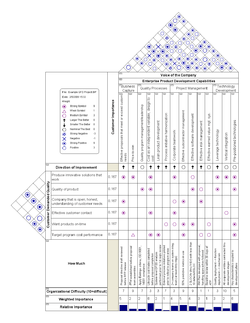Quality function deployment
This article needs additional citations for verification. (June 2007) |

Quality function deployment or "QFD" is a flexible and comprehensive group decision making technique used in product or service development, brand marketing, and product management. QFD can strongly help an organization focus on the critical characteristics of a new or existing product or service from the separate viewpoints of the customer market segments, company, or technology-development needs. The results of the technique yield transparent and visible graphs and matrices that can be reused for future product/service developments.
The focus for the practice and advancement of the technique is The QFD Institute, a non-profit organization dedicated to dissemination and advancement of QFD through on-going R&D, current best practices and tools, and QFD education programs.
History
QFD was originally developed by Drs. Yoji Akao and Shigeru Mizuno in the early 1960s. The House of Quality did not appear until 1972 in the design of an oil tanker by Mitsubishi Heavy Industries. As Akao has reiteratied numerous times, a House of Quality is not QFD, it is just an example of one tool. Other tools extend the analysis beyond quality to cost, technology, reliability, function, parts, technology, manufacturing, and service deployments.
In addition, the same technique can extend the method into the constituent product subsystems, configuration items, assemblies, and parts. From these detail level components, fabrication and assembly process QFD charts can be developed to support statistical process control techniques.
About the Technique
QFD transforms customer needs (the voice of the customer [VOC]) into engineering characteristics (and appropriate test methods) of a product or service, prioritizing each product/service characteristic while simultaneously setting development targets for product or service development. An allied technique, called Pugh Concept Selection can then be used in coordination with QFD to select a promising product or service configuration from among listed alternatives. QFD is applied in a wide variety of services, consumer products, military needs (such as the F-35 Joint Strike Fighter-- see [1]), and emerging technology products. The technique is also used to identify and document competitive marketing strategies and tactics (see example QFD House of Quality for Enterprise Product Development, at right). QFD is considered a key practice of Design for Six Sigma (DFSS) as seen at QFD/DFSS Roadmap. It is also implicated in the new ISO 9000:2000 standard which focuses on customer satisfaction.
Acquiring market needs by listening to the Voice of Customer (VOC), sorting the needs, and numerically prioritizing them (using techniques such as the Analytic Hierarchy Process) are the early tasks in QFD. Traditionally, going to the Gemba (the "real place" where value is created for the customer) is where these customer needs are evidenced and compiled. A Flash tutorial showing the build process of the traditional QFD "House of Quality" (HOQ) can be found at: QFD Flash Tutorial . (Although this example may violate QFD principles, the basic sequence of HOQ building are illustrative.) While many books and articles on "how to do QFD" are available, there is a relative paucity of example matrices available. It has been noted that QFD matrices become highly proprietary due to the high density of product or service information found therein. Notable U.S. companies using QFD techniques include the U.S. automobile manufacturers (GM, Ford, Daimler Chrysler) and their suppliers, IBM, Raytheon, Boeing, Lockheed Martin, and many others.
Since its early use in the United States, QFD met with initial enthusiasm then plummeting popularity when it was discovered that much time could be wasted if poor group decision making techniques were employed. Organizational culture/corporate culture has an effect on the ability to change organizational human processes and on the sustainability of the changes. In particular, in organizations exhibiting strong cultural norms and rich sets of tacit assumptions that prevent objective discussion of historical courses of action, QFD may be resisted due to its ability to expose tacit assumptions and unspoken rules. See Organizational culture and Edgar Schein. It has been suggested that a learning organization can more easily overcome these issues due to the more transparent nature of the organizational culture and to the readiness of the membership to discuss relevant cultural norms.
Results of QFD analysis have been applied in Japan and elsewhere into deploying the high-impact controllable factors in Strategic planning and Strategic management (also known as Hoshin Kanri, Hoshin Planning, or Policy Deployment). This technique somewhat resembles Management by objectives (MBO), but adds a significant element in the goal setting process, called "catchball". Use of these Hoshin techniques by U.S. companies such as Hewlett Packard have been successful in focusing and aligning company resources to follow stated strategic goals throughout an organizational hierarchy.
While originally developed for manufacturing industries, interest in the use of QFD-based ideas in software development commenced with seminal work by R. J. Thackeray [2] and G. Van Treeck "QFD for Embedded Systems and Software Product Development," in GOAL/QPC 6th Annual Conference Proceedings (Boston: GOAL/QPC, 1989), for example in Object-oriented programming (Lamia 1995) and use case driven software development (Denney 2005).
Since the early introduction of QFD, the technique has been developed to shorten the time span and reduce the required group efforts (such as Richard Zultner's Blitz QFD®).
See also
References
Richard Denney. 2005. Succeeding with Use Cases: Working Smart to Deliver Quality, Addison-Wesley Object Technology Series, Addison-Wesley Professional, ISBN 0321316436
Walter Lamia. 1995. “Integrating QFD with Object-oriented Software Design Methodologies.” Presented at the 7th Symposium on QFD.
